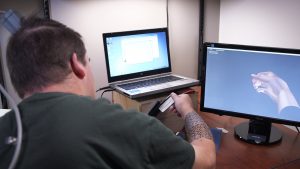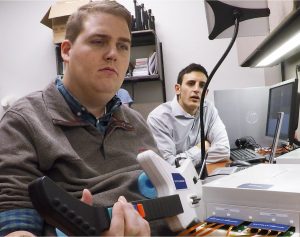It is the first known instance of what is being called “limb animation” and it has been performed by doctors at the Ohio State Wexner Medical Center on a 24 year old quadriplegic man. Through a computer chip implanted in the man’s brain, doctor’s have given him the use of one of his hands back.
Ian Burkhart, 24, was a college freshman five years ago when he had a diving accident that left him paralyzed in this hand and his legs. Two years ago, the doctors implanted a computer chip into Ian’s brain. The doctors had rigged a sleeve to Ian’s arm through which the chip ran so that he could slowly learn how to use his hand again.
Ian learned to focus his very thoughts toward accomplishing a certain task. His progress has been rather remarkable in that he can now use and pour a drink from a bottle, manipulate a straw and even play a guitar oriented video game. Ian’s ability to focus had become extreme.
“It’s crazy,” said Ian, “because I had lost sensation in my hands and I had to watch my hand to know whether I was squeezing or extending the fingers.”
While he remains paralyzed from the waste down, Ian is a business student at the school and still retains some feelings in his shoulders. He can only have the use of his hand while he is connected to the computers in the hospital laboratory so doctor’s are cautioning that this is far from a paralysis cure.
The science of neural engineering has making making huge leaps forward of late as doctors and scientists are able to implant chips that will allow patients to control over certain movements in their bodies. All of this engineering has bypassed spinal surgery. After he was injured, Ian had to go through extensive and painful rehab in Atlanta before he came to Ohio State for the experimental treatment. Ian’s family members were wary of Ian having to undergo brain surgery to have the chip implanted and Ian had reservations himself. But, he went through with it and progress has been made.
“I knew I was going to be taken care of,” Ian said of the surgery and the treatment. “And something’s going to come along to help people like me eventually so why not try.”
PHOTO SOURCES: Ohio State Wexner Medical Center , The New York Times


